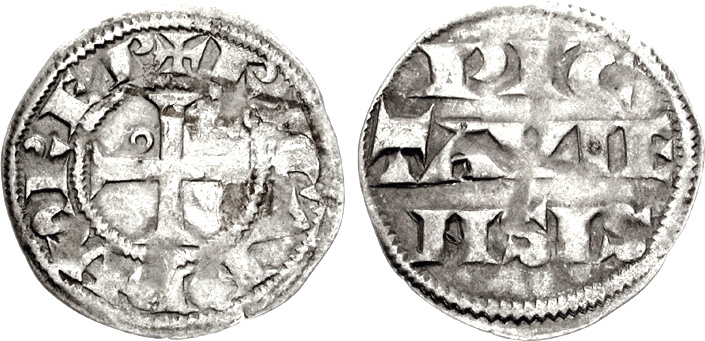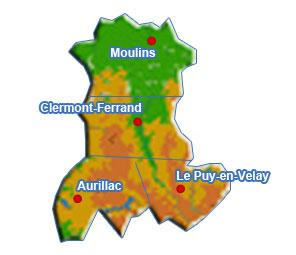|
Aymar I Of Angoulême
Aymar or Adémar (died 2 April, 926) was Count of Poitiers from 890 to 902 and Count of Angoulême from 916 to 926. Biography He was the son of Emenon, Count of Poitiers, and a Robertian mother, probably the daughter of Count Odo I of Troyes. His father was killed in 866 during a fight against his relative Landri, Count of Saintes, and his two sons Aymar and Adalelm were too young to ensure the defense and management of Angoulême and Périgueux, which were the strongholds of Emenon. King Charles the Bald then entrusted the counties and guardianship of the two children to Count Wulgrin in 869. The cousin of King Odo, Aymar appeared at court in 889 at the head of a detachment to join the King's host and fight a new Viking incursion. In 890, Ramnulf II, Duke of Aquitaine and Count of Poitiers, died in Paris, leaving his county to his son Ebles Manzer, still a child, under the care of Géraud d'Aurillac. Ramnulf had been one of the Aquitainian lords not to recognize the electi ... [...More Info...] [...Related Items...] OR: [Wikipedia] [Google] [Baidu] |
Count Of Poitiers
Among the people who have borne the title of Count of Poitiers (, ; or ''Poitou'', in what is now France but in the Middle Ages became part of Aquitaine) are: *Bodilon *Saint Warinus, Warinus (638–677), son of Bodilon *Hatton (735-778) Carolingian Counts * (814-828) * *Renaud of Poitiers, Renaud (795–843) *Bernard II, Count of Poitiers, Bernard II (840 - 844) *Emenon or Emeno (828 – 839), brother of Bernard II *Ranulf I of Poitiers, Ranulph I (839–866) *Ranulf II of Poitiers, Ranulph II (866–890),Monarchs, Rulers, Dynasties And Kingdoms Of The World, by R F Tapsell, 1983, Facts On File, Inc., New York, NY, pag211 son of Ranulph I *William I, Duke of Aquitaine *William II, Duke of Aquitaine *Ebalus of Aquitaine, Ebalus (or Ebles Manzer) (890–892) (illegitimate son of Ranulph II)(first reign– 890–893)(second reign– 902–935) *Aymar I of Angoulême, Aymar (892–902) (son of Emenon) *Ebalus of Aquitaine, Ebalus (or Ebl ... [...More Info...] [...Related Items...] OR: [Wikipedia] [Google] [Baidu] |
Aquitaine
Aquitaine (, ; ; ; ; Poitevin-Saintongeais: ''Aguiéne''), archaic Guyenne or Guienne (), is a historical region of southwestern France and a former Regions of France, administrative region. Since 1 January 2016 it has been part of the administrative region of Nouvelle-Aquitaine. It is situated in the southwest corner of metropolitan France, along the Atlantic Ocean and the Pyrenees mountain range on the border with Spain; for most of its Recorded history, written history Bordeaux has been a vital port and administrative centre. It is composed of the five Departments of France, departments of Dordogne, Lot-et-Garonne, Pyrénées-Atlantiques, Landes (department), Landes and Gironde. Gallia Aquitania was established by the Romans in ancient times and in the Middle Ages, Duchy of Aquitaine, Aquitaine was a kingdom and a duchy, whose boundaries fluctuated considerably. History Ancient history There are traces of human settlement by prehistoric peoples, especially in the Périgord, ... [...More Info...] [...Related Items...] OR: [Wikipedia] [Google] [Baidu] |
William Taillefer I
William "Taillefer" I (died August 962) was also known as William II of Angoulême (being the second William in this family since Wulgrin I. His uncle, William I, being the first). He was the Count of Angoulême from 926 to 945. He was the son of Alduin I. According to one source, his surname, or sobriquet, was acquired "...from the way in which he cut down a Norman Sea-king through his coat of mail". This Norman sea-king is identified as Storis. The name Taillefer was used by subsequent members of this family, especially holders of the title Count of Angoulême. William was not married, but had at least one, and possibly two, illegitimate sons who would later claim the title of Count of Angoulême Count (feminine: countess) is a historical title of nobility in certain European countries, varying in relative status, generally of middling rank in the hierarchy of nobility. Pine, L. G. ''Titles: How the King Became His Majesty''. New York: .... * Aymer II (possibly ruling a ... [...More Info...] [...Related Items...] OR: [Wikipedia] [Google] [Baidu] |
William I Of Périgord
William I of Périgord was a French noble and Count of Périgord from 886 to his death in 918. Biography According to the monk and chronicler Ademar of Chabannes, William was the second son of Wulgrin, Count of Angoulême and his wife Regelindis, the daughter of Bernard of Septimania, Count of Barcelona. Wulgrin I died in 886, leaving Angoulême to his first son Alduin, and Périgord to William. William died in 918 and was succeeded by his son Bernard Bernard ('' Bernhard'') is a French and West Germanic masculine given name. It has West Germanic origin and is also a surname. The name is attested from at least the 9th century. West Germanic ''Bernhard'' is composed from the two elements ''be ....Adémar de Chabannes, Chronique , published by J. Chavanon, Paris, Picard, 1897. References {{Reflist 918 deaths Counts of Périgord ... [...More Info...] [...Related Items...] OR: [Wikipedia] [Google] [Baidu] |
Alduin I Of Angoulême
Alduin (or Hildouin) I (died 27 March 916) was the Count of Angoulême from 886. He was the son of Wulgrin I, Count of Angoulême, whom he succeeded on 3 May 886. Like his father, he was charged with defending parts of Aquitaine against the Viking invaders. Alduin's wife is unknown, but they had a son, William II of Angoulême, (William Taillefer I; 926–945) Count of Angoulême Count (feminine: countess) is a historical title of nobility in certain European countries, varying in relative status, generally of middling rank in the hierarchy of nobility. Pine, L. G. ''Titles: How the King Became His Majesty''. New York: .... References Sources *http://homepages.rootsweb.ancestry.com/~cousin/html Histoire P@ssion (in French) 916 deaths Counts of Angoulême Year of birth unknown House of Girard 9th-century people from West Francia {{France-noble-stub ... [...More Info...] [...Related Items...] OR: [Wikipedia] [Google] [Baidu] |
William I Of Perigord
William is a masculine given name of Germanic origin. It became popular in England after the Norman conquest in 1066,All Things William"Meaning & Origin of the Name"/ref> and remained so throughout the Middle Ages and into the modern era. It is sometimes abbreviated "Wm." Shortened familiar versions in English include Will or Wil, Wills, Willy, Willie, Bill, Billie, and Billy. A common Irish form is Liam. Scottish diminutives include Wull, Willie or Wullie (as in Oor Wullie). Female forms include Willa, Willemina, Wilma and Wilhelmina. Etymology William is related to the German given name ''Wilhelm''. Both ultimately descend from Proto-Germanic ''*Wiljahelmaz'', with a direct cognate also in the Old Norse name ''Vilhjalmr'' and a West Germanic borrowing into Medieval Latin ''Willelmus''. The Proto-Germanic name is a compound of *''wiljô'' "will, wish, desire" and *''helmaz'' "helm, helmet".Hanks, Hardcastle and Hodges, ''Oxford Dictionary of First Names'', Oxford Univers ... [...More Info...] [...Related Items...] OR: [Wikipedia] [Google] [Baidu] |
Limousin
Limousin (; ) is a former administrative region of southwest-central France. Named after the old province of Limousin, the administrative region was founded in 1960. It comprised three departments: Corrèze, Creuse, and Haute-Vienne. On 1 January 2016, it became part of the new administrative region of Nouvelle-Aquitaine. Situated mostly in the west side of south-central French Massif Central, Limousin had (in 2010) 742,770 inhabitants spread out on nearly , making it the least populated region of metropolitan France. Forming part of the southwest of the country, Limousin was bordered by the regions of Centre-Val de Loire to the north, Auvergne to the east, Midi-Pyrénées to the south, Aquitaine to the southwest, and Poitou-Charentes to the west. Limousin was also part of the larger historical Occitania region. Population The population of Limousin was aging and, until 1999, was declining. The department of Creuse had the oldest population of any in France. Between ... [...More Info...] [...Related Items...] OR: [Wikipedia] [Google] [Baidu] |
Charles The Simple
Charles III (17 September 879 – 7 October 929), called the Simple or the Straightforward (from the Latin ''Carolus Simplex''), was the king of West Francia from 898 until 922 and the king of Lotharingia from 911 until 919–923. He was a member of the Carolingian dynasty. Early life Charles was the third and posthumous son of King Louis the Stammerer by his second wife Adelaide of Paris. As a child, Charles was prevented from succeeding to the throne at the time of the death in 884 of his half-brother, king Carloman II. Instead, Frankish nobles of the realm asked his cousin, Emperor Charles the Fat, to assume the crown. He was also prevented from succeeding the unpopular Charles the Fat, who was deposed in November 887 and died in January 888, although it is unknown if his overthrow was accepted or even made known in West Francia before his death. The nobility then elected Odo, the hero of the Siege of Paris (885–886) as the new king, although there was a faction tha ... [...More Info...] [...Related Items...] OR: [Wikipedia] [Google] [Baidu] |
Carolingian Dynasty
The Carolingian dynasty ( ; known variously as the Carlovingians, Carolingus, Carolings, Karolinger or Karlings) was a Franks, Frankish noble family named after Charles Martel and his grandson Charlemagne, descendants of the Pippinids, Arnulfing and Pippinid clans of the 7th century AD. The dynasty consolidated its power in the 8th century, eventually making the offices of mayor of the palace and ''dux et princeps Francorum'' hereditary, and becoming the ''de facto'' rulers of the Franks as the real powers behind the Merovingian throne. In 751 the Merovingian dynasty which had ruled the Franks was overthrown with the consent of the Papacy and the aristocracy, and Pepin the Short, son of Martel, was crowned King of the Franks. The Carolingian dynasty reached its peak in 800 with the crowning of Charlemagne as the first Holy Roman Emperor, Emperor of the Romans in the West in over three centuries. Nearly every monarch of France from Charlemagne's son Louis the Pious until the pen ... [...More Info...] [...Related Items...] OR: [Wikipedia] [Google] [Baidu] |
Auvergne
Auvergne (; ; or ) is a cultural region in central France. As of 2016 Auvergne is no longer an administrative division of France. It is generally regarded as conterminous with the land area of the historical Province of Auvergne, which was dissolved in 1790, and with the now-defunct administrative region of Auvergne, which existed from 1956 to 2015. The region is home to a chain of volcanoes known collectively as the " chaîne des Puys". The volcanoes began forming about 70,000 years ago, and most have eroded, leaving plugs of hardened magma that form rounded hilltops known as puys. The last confirmed eruption occurred around 4040 BCE. Geography Auvergne is known for its mountain ranges and dormant volcanoes. Together the Monts Dore and the Chaîne des Puys include 80 volcanoes. The Puy de Dôme is the highest volcano in the region, with an altitude of . The Sancy Massif in the Monts Dore is the highest point in Auvergne at . The northern part is covered in hil ... [...More Info...] [...Related Items...] OR: [Wikipedia] [Google] [Baidu] |


